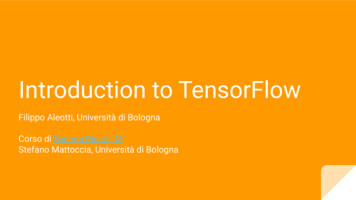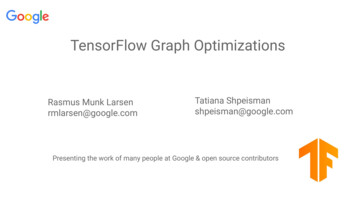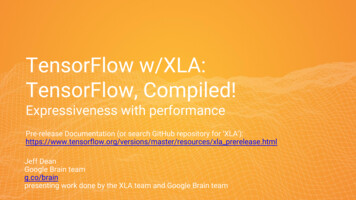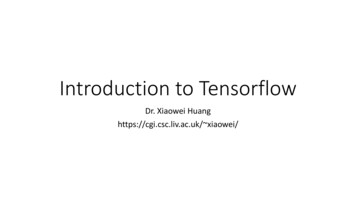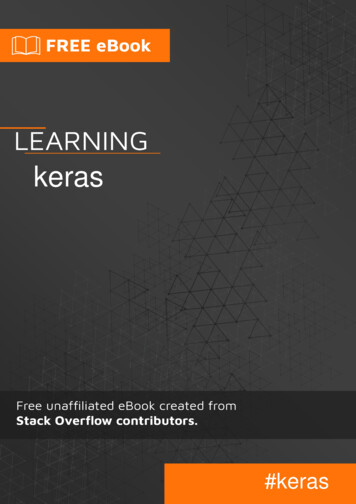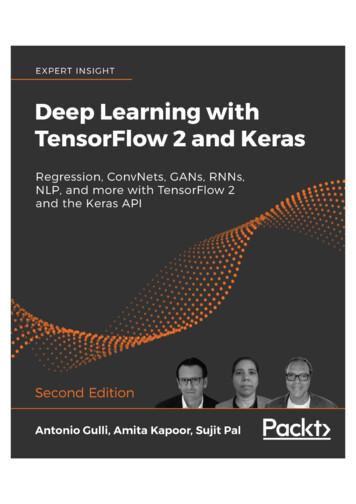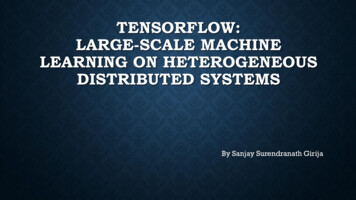
Transcription
TensorFlow: A system for large-scale machine learningMartı́n Abadi, Paul Barham, Jianmin Chen, Zhifeng Chen, Andy Davis, Jeffrey Dean,Matthieu Devin, Sanjay Ghemawat, Geoffrey Irving, Michael Isard, Manjunath Kudlur,Josh Levenberg, Rajat Monga, Sherry Moore, Derek G. Murray, Benoit Steiner, Paul Tucker,Vijay Vasudevan, Pete Warden, Martin Wicke, Yuan Yu, and Xiaoqiang ZhengGoogle BrainAbstractTensorFlow is a machine learning system that operates atlarge scale and in heterogeneous environments. TensorFlow uses dataflow graphs to represent computation,shared state, and the operations that mutate that state. Itmaps the nodes of a dataflow graph across many machinesin a cluster, and within a machine across multiple computational devices, including multicore CPUs, generalpurpose GPUs, and custom-designed ASICs known asTensor Processing Units (TPUs). This architecture givesflexibility to the application developer: whereas in previous “parameter server” designs the management of sharedstate is built into the system, TensorFlow enables developers to experiment with novel optimizations and training algorithms. TensorFlow supports a variety of applications,with a focus on training and inference on deep neural networks. Several Google services use TensorFlow in production, we have released it as an open-source project, andit has become widely used for machine learning research.In this paper, we describe the TensorFlow dataflow modeland demonstrate the compelling performance that TensorFlow achieves for several real-world applications.1IntroductionIn recent years, machine learning has driven advances inmany different fields [3, 5, 24, 25, 29, 31, 42, 47, 50,52, 57, 67, 68, 72, 76]. We attribute this success to theinvention of more sophisticated machine learning models [44, 54], the availability of large datasets for tackling problems in these fields [9, 64], and the development of software platforms that enable the easy use oflarge amounts of computational resources for trainingsuch models on these large datasets [14, 20].We have developed the TensorFlow system for experimenting with new models, training them on largeUSENIX Associationdatasets, and moving them into production. We havebased TensorFlow on many years of experience with ourfirst-generation system, DistBelief [20], both simplifying and generalizing it to enable researchers to explorea wider variety of ideas with relative ease. TensorFlowsupports both large-scale training and inference: it efficiently uses hundreds of powerful (GPU-enabled) serversfor fast training, and it runs trained models for inference inproduction on various platforms, ranging from large distributed clusters in a datacenter, down to running locallyon mobile devices. At the same time, it is flexible enoughto support experimentation and research into new machinelearning models and system-level optimizations.TensorFlow uses a unified dataflow graph to represent both the computation in an algorithm and the stateon which the algorithm operates. We draw inspirationfrom the high-level programming models of dataflow systems [2, 21, 34] and the low-level efficiency of parameter servers [14, 20, 49]. Unlike traditional dataflow systems, in which graph vertices represent functional computation on immutable data, TensorFlow allows vertices torepresent computations that own or update mutable state.Edges carry tensors (multi-dimensional arrays) betweennodes, and TensorFlow transparently inserts the appropriate communication between distributed subcomputations.By unifying the computation and state management in asingle programming model, TensorFlow allows programmers to experiment with different parallelization schemesthat, for example, offload computation onto the serversthat hold the shared state to reduce the amount of networktraffic. We have also built various coordination protocols,and achieved encouraging results with synchronous replication, echoing recent results [10, 18] that contradict thecommonly held belief that asynchronous replication is required for scalable learning [14, 20, 49].Over the past year, more than 150 teams at Google haveused TensorFlow, and we have released the system as an12th USENIX Symposium on Operating Systems Design and Implementation265
open-source project.1 Thanks to our large community ofusers we have gained experience with many different machine learning applications. In this paper, we focus onneural network training as a challenging systems problem,and select two representative applications from this space:image classification and language modeling. These applications stress computational throughput and aggregatemodel size respectively, and we use them both to demonstrate the extensibility of TensorFlow, and to evaluate theefficiency and scalability of our present implementation.and write back “delta” updates to each parameter server,which combines the updates with its current state.Although DistBelief has enabled many Google products to use deep neural networks and formed the basis ofmany machine learning research projects, we soon beganto feel its limitations. Its Python-based scripting interfacefor composing pre-defined layers was adequate for userswith simple requirements, but our more advanced userssought three further kinds of flexibility:tain the current version of the model parameters. DistBelief’s programming model is similar to Caffe’s [38]: theuser defines a neural network as a directed acyclic graphof layers that terminates with a loss function. A layer isa composition of mathematical operators: for example, afully connected layer multiplies its input by a weight matrix, adds a bias vector, and applies a non-linear function(such as a sigmoid) to the result. A loss function is a scalarfunction that quantifies the difference between the predicted value (for a given input data point) and the groundtruth. In a fully connected layer, the weight matrix andbias vector are parameters, which a learning algorithmwill update in order to minimize the value of the loss function. DistBelief uses the DAG structure and knowledgeof the layers’ semantics to compute gradients for eachof the model parameters, via backpropagation [63]. Because the parameter updates in many algorithms are commutative and have weak consistency requirements [61],the worker processes can compute updates independentlyDefining new training algorithms DistBelief workersfollow a fixed execution pattern: read a batch of input dataand the current parameter values, compute the loss function (a forward pass through the network), compute gradients for each of the parameter (a backward pass), andwrite the gradients back to the parameter server. This pattern works for training simple feed-forward neural networks, but fails for more advanced models, such as recurrent neural networks, which contain loops [39]; adversarial networks, in which two related networks are trained alternately [26]; and reinforcement learning models, wherethe loss function is computed by some agent in a separatesystem, such as a video game emulator [54]. Moreover,there are many other machine learning algorithms—suchas expectation maximization, decision forest training, andlatent Dirichlet allocation—that do not fit the same moldas neural network training, but could also benefit from acommon, well-optimized distributed runtime.Defining new layers For efficiency, we implementedDistBelief layers as C classes. Using a separate, lessfamiliar programming language for implementing layers2 Background & motivationis a barrier for machine learning researchers who seek toexperiment with new layer architectures, such as sampledWe begin by describing the limitations of our previoussoftmax classifiers [37] and attention modules [53].system (§2.1) and outlining the design principles that weused in the development of TensorFlow (§2.2).Refining the training algorithms Many neural networks are trained using stochastic gradient descent(SGD), which iteratively refines the parameters of the net2.1 Previous system: DistBeliefwork by moving them in the direction that maximally deTensorFlow is the successor to DistBelief, which is creases the value of the loss function. Several refinementsthe distributed system for training neural networks that to SGD accelerate convergence by changing the updateGoogle has used since 2011 [20]. DistBelief uses the pa- rule [23, 66]. Researchers often want to experiment withrameter server architecture, and here we criticize its lim- new optimization methods, but doing that in DistBeliefitations, but other systems based on this architecture have involves modifying the parameter server implementation.addressed these limitations in other ways [11, 14, 49]; we Moreover, the get() and put() interface for the parameter server is not ideal for all optimization methods:discuss those systems in Subsection 2.3.In the parameter server architecture, a job comprises sometimes a set of related parameters must be updatedtwo disjoint sets of processes: stateless worker processes atomically, and in many cases it would be more efficientthat perform the bulk of the computation when training a to offload computation onto the parameter server, andmodel, and stateful parameter server processes that main- thereby reduce the amount of network traffic.1 Software266available from https://tensorflow.org.In addition, we designed DistBelief with a single platform in mind: a large distributed cluster of multicore12th USENIX Symposium on Operating Systems Design and ImplementationUSENIX Association
# 1. Construct a graph representing the model.x tf.placeholder(tf.float32, [BATCH SIZE, 784])y tf.placeholder(tf.float32, [BATCH SIZE, 10])# Placeholder for input.# Placeholder for labels.W 1 tf.Variable(tf.random uniform([784, 100]))b 1 tf.Variable(tf.zeros([100]))layer 1 tf.nn.relu(tf.matmul(x, W 1) b 2)# 784x100 weight matrix.# 100-element bias vector.# Output of hidden layer.W 2 tf.Variable(tf.random uniform([100, 10]))b 2 tf.Variable(tf.zeros([10]))layer 2 tf.matmul(layer 1, W 2) b 2# 100x10 weight matrix.# 10-element bias vector.# Output of linear layer.# 2. Add nodes that represent the optimization algorithm.loss tf.nn.softmax cross entropy with logits(layer 2, y)train op tf.train.AdagradOptimizer(0.01).minimize(loss)# 3. Execute the graph on batches of input data.with tf.Session() as sess:sess.run(tf.initialize all variables())for step in range(NUM STEPS):x data, y data .sess.run(train op, {x: x data, y: y data})#####Connect to the TF runtime.Randomly initialize weights.Train iteratively for NUM STEPS.Load one batch of input data.Perform one training step.Figure 1: An image classifier written using TensorFlow’s Python API. This program is a simple solution to the MNISTdigit classification problem [48], with 784-pixel images and 10 output classes.servers [20]. We were able to add support for GPU acceleration, when it became clear that this accelerationwould be crucial for executing convolutional kernels efficiently [44], but DistBelief remains a heavyweight systemthat is geared for training deep neural networks on hugedatasets, and is difficult to scale down to other environments. In particular, many users want to hone their modellocally on a GPU-powered workstation, before scaling thesame code to train on a much larger dataset. After training a model on a cluster, the next step is to push themodel into production, which might involve integratingthe model into an online service, or deploying it onto amobile device for offline execution. Each of these taskshas some common computational structure, but our colleagues found it necessary to use or create separate systems that satisfy the different performance and resourcerequirements of each platform. TensorFlow provides asingle programming model and runtime system for all ofthese environments.cations on distributed clusters, local workstations, mobile devices, and custom-designed accelerators. A highlevel scripting interface (Figure 1) wraps the constructionof dataflow graphs and enables users to experiment withdifferent model architectures and optimization algorithmswithout modifying the core system. In this subsection, webriefly highlight TensorFlow’s core design principles:Dataflow graphs of primitive operators Both TensorFlow and DistBelief use a dataflow representation for theirmodels, but the most striking difference is that a DistBelief model comprises relatively few complex “layers”,whereas the corresponding TensorFlow model representsindividual mathematical operators (such as matrix multiplication, convolution, etc.) as nodes in the dataflowgraph. This approach makes it easier for users to compose novel layers using a high-level scripting interface.Many optimization algorithms require each layer to havedefined gradients, and building layers out of simple operators makes it easy to differentiate these models automatically (§4.1). In addition to the functional operators, werepresent mutable state, and the operations that update it,2.2 Design principlesas nodes in the dataflow graph, thus enabling experimenWe designed TensorFlow to be much more flexible than tation with different update rules.DistBelief, while retaining its ability to satisfy the de- Deferred execution A typical TensorFlow applicationmands of Google’s production machine learning work- has two distinct phases: the first phase defines the proloads. TensorFlow provides a simple dataflow-based pro- gram (e.g., a neural network to be trained and the updategramming abstraction that allows users to deploy appli- rules) as a symbolic dataflow graph with placeholders forUSENIX Association12th USENIX Symposium on Operating Systems Design and Implementation267
the input data and variables that represent the state; andthe second phase executes an optimized version of theprogram on the set of available devices. By deferring theexecution until the entire program is available, TensorFlow can optimize the execution phase by using globalinformation about the computation. For example, TensorFlow achieves high GPU utilization by using the graph’sdependency structure to issue a sequence of kernels to theGPU without waiting for intermediate results. While thisdesign choice makes execution more efficient, we havehad to push more complex features—such as dynamiccontrol flow (§3.4)—into the dataflow graph, so that models using these features enjoy the same optimizations.Common abstraction for heterogeneous acceleratorsIn addition to general-purpose devices such as multicoreCPUs and GPUs, special-purpose accelerators for deeplearning can achieve significant performance improvements and power savings. At Google, our colleagueshave built the Tensor Processing Unit (TPU) specificallyfor machine learning; TPUs yield an order of magnitudeimprovement in performance-per-watt compared to alternative state-of-the-art technology [40]. To support theseaccelerators in TensorFlow, we define a common abstraction for devices. At a minimum, a device must implementmethods for (i) issuing a kernel for execution, (ii) allocating memory for inputs and outputs, and (iii) transferringbuffers to and from host memory. Each operator (e.g.,matrix multiplication) can have multiple specialized implementations for different devices. As a result, the sameprogram can easily target GPUs, TPUs, or mobile CPUsas required for training, serving, and offline inference.TensorFlow uses tensors of primitive values as a common interchange format that all devices understand. Atthe lowest level, all tensors in TensorFlow are dense;sparse tensors can be represented in terms of dense ones(§3.1). This decision ensures that the lowest levels of thesystem have simple implementations for memory allocation and serialization, thus reducing the framework overhead. Tensors also enable other optimizations for memorymanagement and communication, such as RDMA and direct GPU-to-GPU transfer.The main consequence of these principles is that inTensorFlow there is no such thing as a parameter server.On a cluster, we deploy TensorFlow as a set of tasks(named processes that can communicate over a network)that each export the same graph execution API and contain one or more devices. Typically a subset of those tasksassumes the role that a parameter server plays in othersystems [11, 14, 20, 49], and we therefore call them PStasks; the others are worker tasks. However, since a PStask is capable of running arbitrary TensorFlow graphs,268it is more flexible than a conventional parameter server:users can program it with the same scripting interface thatthey use to define models. This flexibility is the key difference between TensorFlow and contemporary systems,and in the rest of the paper we will discuss some of theapplications that this flexibility enables.2.3Related workSingle-machine frameworks Many machine learningresearchers carry out their work on a single—often GPUequipped—computer [43, 44], and several single-machineframeworks support this scenario. Caffe [38] is a highperformance framework for training declaratively specified neural networks on multicore CPUs and GPUs. Asdiscussed above, its programming model is similar toDistBelief (§2.1), so it is easy to compose models fromexisting layers, but relatively difficult to add new layersor optimizers. Theano [2] allows programmers to expressa model as a dataflow graph of primitive operators, andgenerates efficient compiled code for training that model.Its programming model is closest to TensorFlow, and itprovides much of the same flexibility in a single machine.Unlike Caffe, Theano, and TensorFlow, Torch [17] offers a powerful imperative programming model for scientific computation and machine learning. It allows finegrained control over the execution order and memory utilization, which enables power users to optimize the performance of their programs. While this flexibility is useful for research, Torch lacks the advantages of a dataflowgraph as a portable representation across small-scale experimentation, production training, and deployment.Batch dataflow systems Starting with MapReduce [21], batch dataflow systems have been appliedto a large number of machine learning algorithms [70],and more recent systems have focused on increasingexpressivity and performance. DryadLINQ [74] adds ahigh-level query language that supports more sophisticated algorithms than MapReduce. Spark [75] extendsDryadLINQ with the ability to cache previously computed datasets in memory, and is therefore better suited toiterative machine learning algorithms (such as k-meansclustering and logistic regression) when the input data fitin memory. Dandelion extends DryadLINQ with codegeneration for GPUs [62] and FPGAs [16].The principal limitation of a batch dataflow system isthat it requires the input data to be immutable, and allof the subcomputations to be deterministic, so that thesystem can re-execute subcomputations when machinesin the cluster fail. This feature—which is beneficial formany conventional workloads—makes updating a ma-12th USENIX Symposium on Operating Systems Design and ImplementationUSENIX Association
ModPartStitchFalse branchSumParametersRead paramsShuffle queueInputdataPeriodiccheckpointApply gradsQueueFwdReaderBackTrainingPreprocessingDist. FSFigure 2: A schematic TensorFlow dataflow graph for a training pipeline, containing subgraphs for reading input data,preprocessing, training, and checkpointing state.chine learning model an expensive operation. For example, the SparkNet system for training deep neural networks on Spark takes 20 seconds to broadcast weights andcollect updates from five workers [55]. As a result, inthese systems, each model update step must process largerbatches, slowing convergence [8]. We show in Subsection 6.3 that TensorFlow can train larger models on largerclusters with step times as short as 2 seconds.Parameter servers As we discuss in Subsection 2.1, aparameter server architecture uses a set of servers to manage shared state that is updated by a set of parallel workers. This architecture emerged in work on scalable topicTrainingInferencelibs it can applymodeling [65],andlibrariesDistBelief showedhowto deep neural network training.C Project[14] fur.client AdamPython clientther applied this architecture for the efficient training ofC API and Li et al.’s “Parameconvolutional neural networks;ter Server” [49] added innovations in consistency modDistributedmasterexecutorels, fault tolerance,andelastic Dataflowrescaling.Despite earlierskepticism that parameter servers would be compatibleConst Var MatMul Conv2D ReLU Queue .with GPU accelerationCui et al. recently showedKernel[14],implementationsthat a parameter server specialized for use with GPUs canachieve speedupssmall.clusters[18].GPU .RPC onRDMACPUMXNet [11]is perhapsNetworkinglayer the closestDevicesystemlayer in designto TensorFlow. It uses a dataflow graph to represent thecomputation at each worker, and uses a parameter serverto scale training across multiple machines. The MXNetparameter server exports a key-value store interface thatsupports aggregating updates sent from multiple devicesin each worker, and using an arbitrary user-provided function to combine incoming updates with the current value.The MXNet key-value store interface [22] does not currently allow sparse gradient updates within a single value,which are crucial for the distributed training of large models (§4.2), and adding this feature would require modifications to the core system.The parameter server architecture meets many of ourrequirements, and with sufficient engineering effort itwould be possible to build most of the features that wedescribe in this paper into a parameter server. For Tensor-USENIX AssociationFlow we sought a high-level programming model that allows users to customize the code that runs in all parts ofthe system, so that the cost of experimentation with newoptimization algorithms and model architectures is lower.In the next section, we describe the building blocks of aTensorFlow program in more detail.3TensorFlow execution modelTensorFlow uses a single dataflow graph to representall computation and state in a machine learning algorithm, including the individual mathematical operations,the parameters and their update rules, and the input preprocessing (Figure 2). The dataflow graph expresses thecommunication between subcomputations explicitly, thusmaking it easy to execute independent computations inparallel and to partition computations across multiple devices. TensorFlow differs from batch dataflow systems(§2.3) in two respects: The model supports multiple concurrent executionson overlapping subgraphs of the overall graph. Individual vertices may have mutable state that canbe shared between different executions of the graph.The key observation in the parameter server architecture [14, 20, 49] is that mutable state is crucial whentraining very large models, because it becomes possible tomake in-place updates to very large parameters, and propagate those updates to parallel training steps as quicklyas possible. Dataflow with mutable state enables TensorFlow to mimic the functionality of a parameter server,but with additional flexibility, because it becomes possible to execute arbitrary dataflow subgraphs on the machines that host the shared model parameters. As a result, our users have been able to experiment with differentoptimization algorithms, consistency schemes, and parallelization strategies.12th USENIX Symposium on Operating Systems Design and Implementation269
3.1Dataflow graph elements27012th USENIX Symposium on Operating Systems Design and Implementationexample, AssignAdd takes a reference handle r and atensor value x, and when executed performs the updateIn a TensorFlow graph, each vertex represents a unit of State′ [r] State[r] x. Subsequent Read(r) operalocal computation, and each edge represents the output tions produce the value State′ [r].from, or input to, a vertex. We refer to the computationat vertices as operations, and the values that flow along Stateful operations: queues TensorFlow includes sevedges as tensors. In this subsection, we describe the com- eral queue implementations, which support more advanced forms of coordination. The simplest queue ismon types of operations and tensors.FIFOQueue, which owns an internal queue of tensors,Tensors In TensorFlow, we model all data as tensorsand allows concurrent access in first-in-first-out order.(n-dimensional arrays) with the elements having oneOther types of queues dequeue tensors in random and priof a small number of primitive types, such as int32,ority orders, which ensure that input data are sampled apfloat32, or string (where string can represent arpropriately. Like a Variable, the FIFOQueue operabitrary binary data). Tensors naturally represent the inputstion produces a reference handle that can be consumed byto and results of the common mathematical operations inone of the standard queue operations, such as Enqueuemany machine learning algorithms: for example, a matrixand Dequeue. These operations push their input onto themultiplication takes two 2-D tensors and produces a 2-Dtail of the queue and, respectively, pop the head elementtensor; and a batch 2-D convolution takes two 4-D tensorsand output it. Enqueue will block if its given queue isand produces another 4-D tensor.full, and Dequeue will block if its given queue is empty.At the lowest level, all TensorFlow tensors are dense,When queues are used in an input preprocessing pipeline,for the reasons we discuss in Subsection 2.2. TensorFlowthis blocking provides backpressure; it also supports synoffers two alternatives for representing sparse data: eitherchronization (§4.4). The combination of queues and dyencode the data into variable-length string elements ofnamic control flow (§3.4) can also implement a form ofa dense tensor, or use a tuple of dense tensors (e.g., anstreaming computation between subgraphs.n-D sparse tensor with m non-zero elements can be represented in coordinate-list format as an m n matrix ofcoordinates and a length-m vector of values). The shape 3.2 Partial and concurrent executionof a tensor can vary in one or more of its dimensions,which makes it possible to represent sparse tensors with TensorFlow uses a dataflow graph to represent all possiblecomputations in a particular application. The API for exdiffering numbers of elements.ecuting a graph allows the client to specify declarativelyOperations An operation takes m 0 tensors as input the subgraph that should be executed. The client selectsand produces n 0 tensors as output. An operation has zero or more edges to feed input tensors into the dataflow,a named “type” (such as Const, MatMul, or Assign) and one or more edges to fetch output tensors from theand may have zero or more compile-time attributes that dataflow; the runtime then prunes the graph to contain thedetermine its behavior. An operation can be polymorphic necessary set of operations. Each invocation of the API isand variadic at compile-time: its attributes determine both called a step, and TensorFlow supports multiple concurthe expected types and arity of its inputs and outputs.rent steps on the same graph. Stateful operations allowFor example, the simplest operation Const has no in- steps to share data and synchronize when necessary.puts and a single output; its value is a compile-time atFigure 2 shows a typical training application, withtribute. For example, AddN sums multiple tensors of the multiple subgraphs that execute concurrently and interactsame element type, and it has a type attribute T and an through shared variables and queues. The core traininginteger attribute N that define its type signature.subgraph depends on a set of model parameters and on inStateful operations: variables An operation can con- put batches from a queue. Many concurrent steps of thetain mutable state that is read and/or written each time training subgraph update the model based on different init executes. A Variable operation owns a mutable put batches, to implement data-parallel training. To fillbuffer that may be used to store the shared parameters the input queue, concurrent preprocessing steps transformof a model as it is trained. A Variable has no inputs, individual input records (e.g., decoding images and applyand produces a reference handle, which acts as a typed ing random distortions), and a separate I/O subgraph readscapability for reading and writing the buffer. A Read records from a distributed file system. A checkpointingoperation takes a reference handle r as input, and out- subgraph runs periodically for fault tolerance (§4.3).puts the value of the variable (State[r]) as a dense tenPartial and concurrent execution is responsible forsor. Other operations modify the underlying buffer: for much of TensorFlow’s flexibility. Adding mutable stateUSENIX Association
and coordination via queues makes it possible to specify a wide variety of model architectures in user-levelcode, which enables advanced users to experiment without modifying the internals of the TensorFlow runtime.By default, concurrent executions of a TensorFlow subgraph run asynchronously with respect to one another.This asynchrony makes it straightforward to implementmachine learning algorithms with weak consistency requirements [61], which include many neural networktraining algorithms [20]. As we discuss later, TensorFlowalso provides the primitives needed to synchronize workers during training (§4.4), which has led to promising results on some learning tasks (§6.3).3.3Distributed executionDataflow simplifies distributed execution, because itmakes communication between subcomputations explicit.It enables the same TensorFlow program to be deployedto a cluster of GPUs for training, a cluster of TPUs forserving, and a cellphone for mobile inference.Each operation resides on a particular device, such as aCPU or GPU in a p
TensorFlow provides a single programming model and runtime system for all of these environments. 2.2 Design principles We designed TensorFlow to be much more flexible than DistBelief, while retaining its ability to satisfy the de-mands of Google’s production machine learning wo
